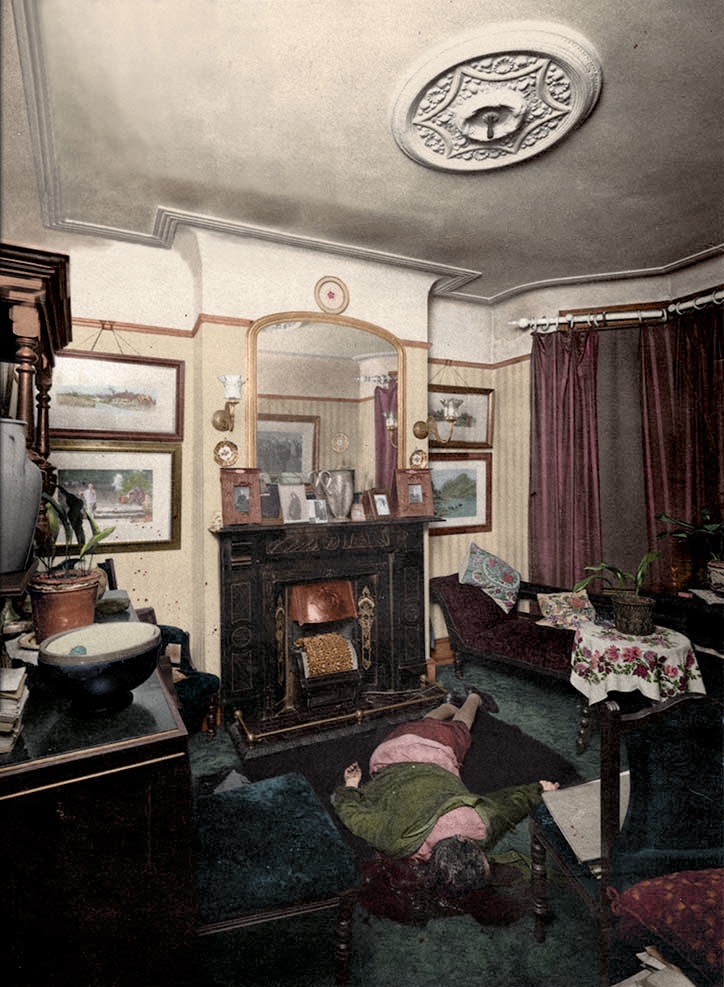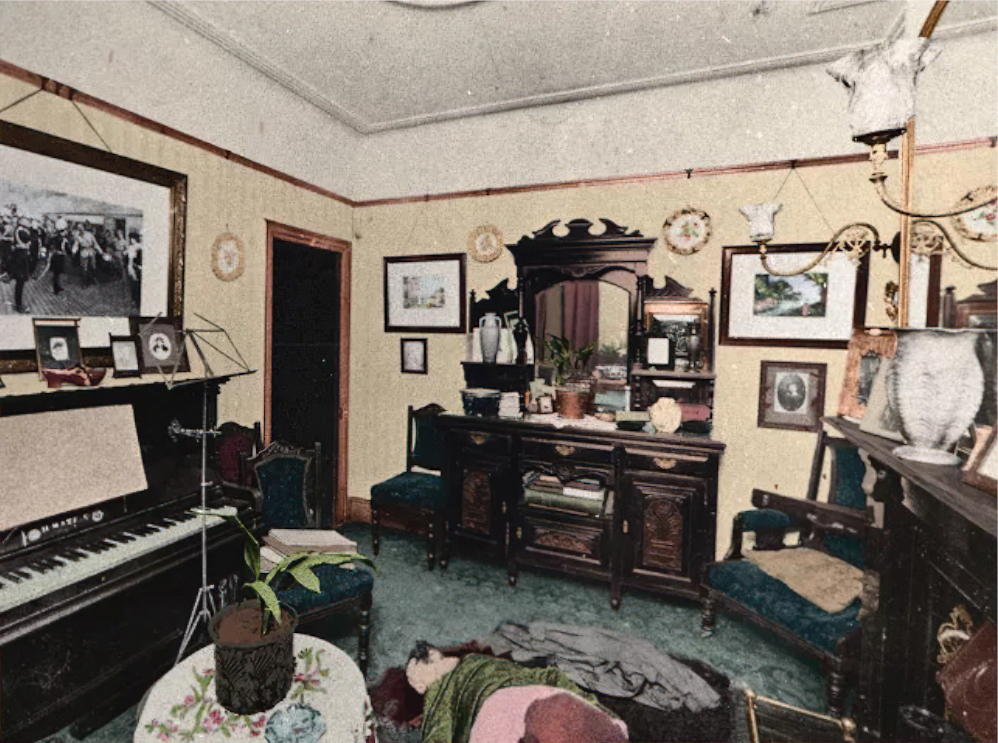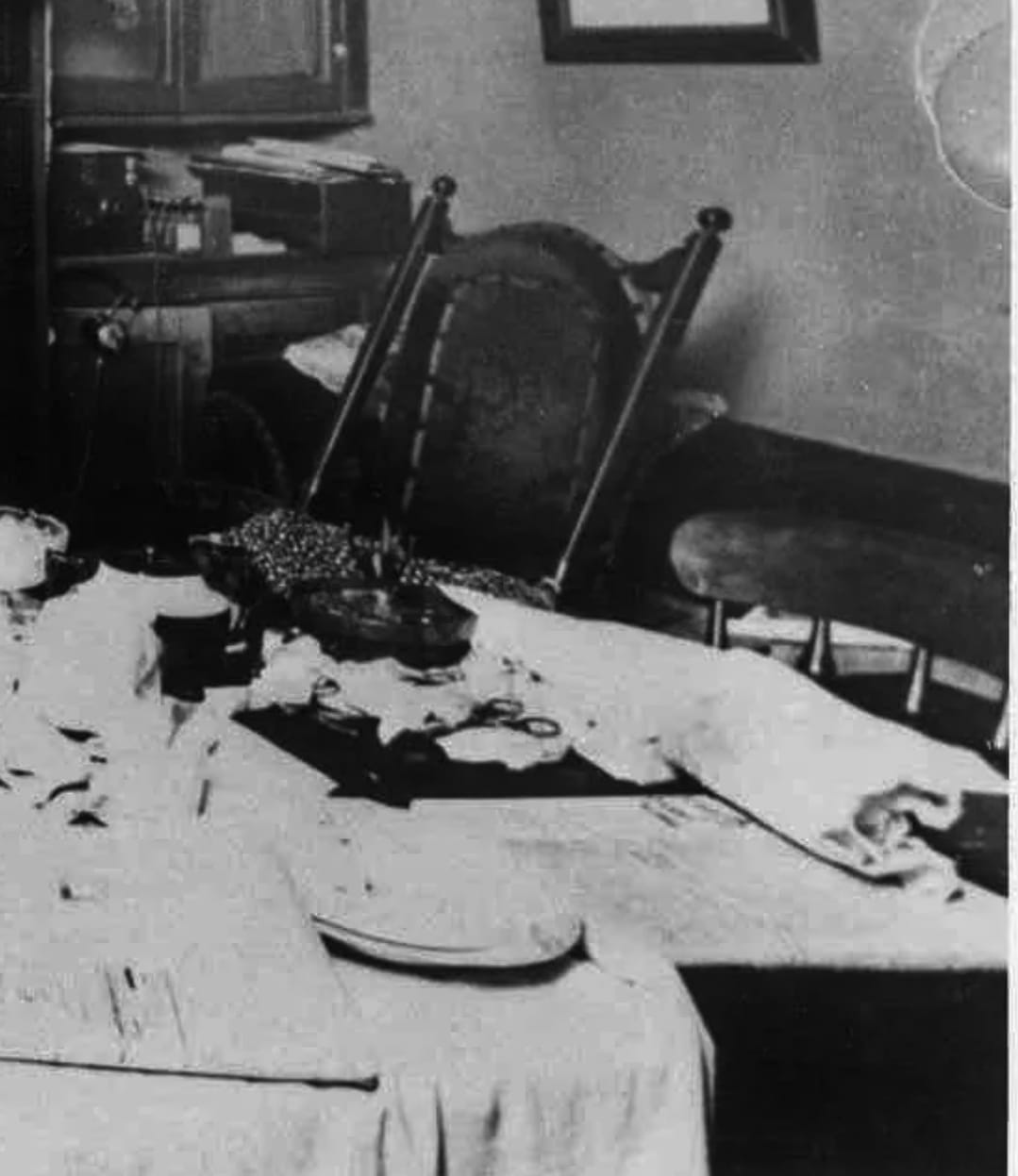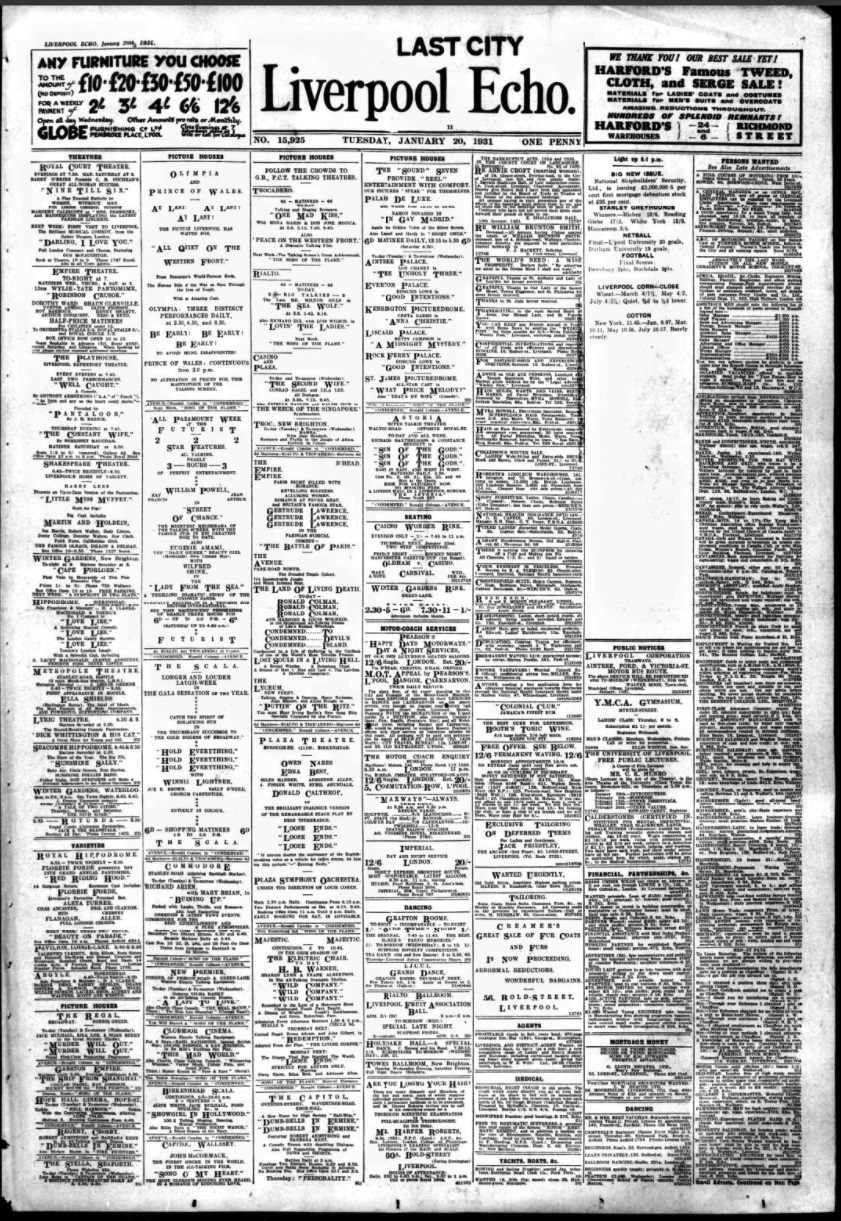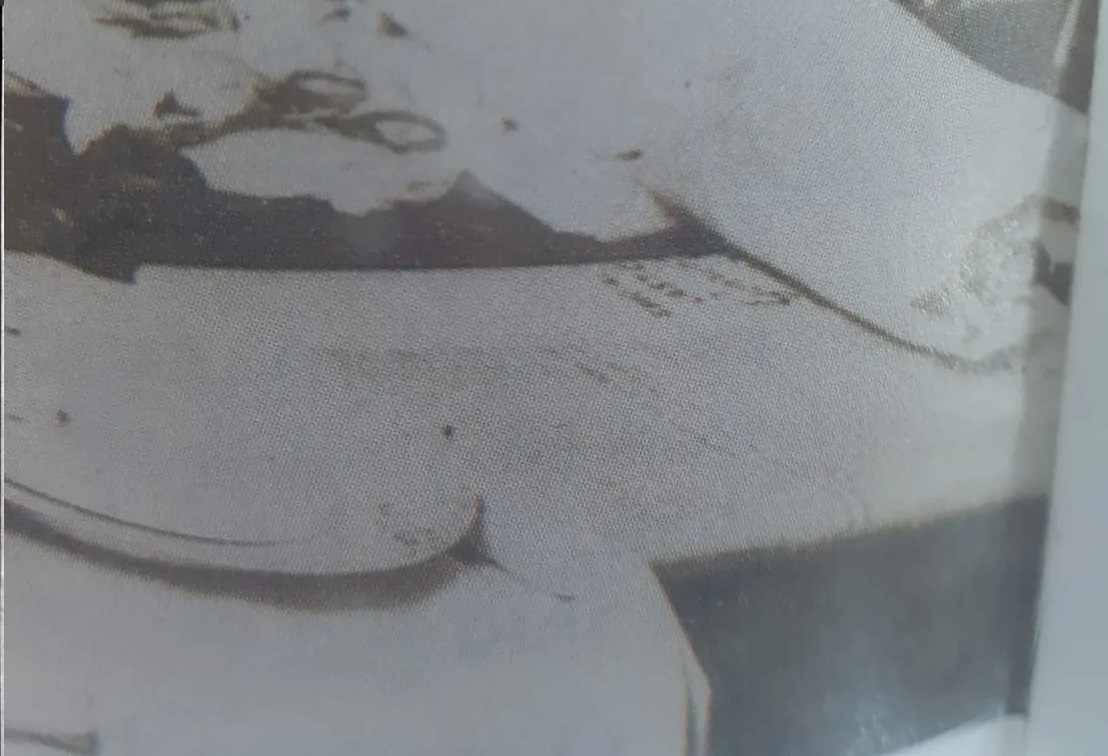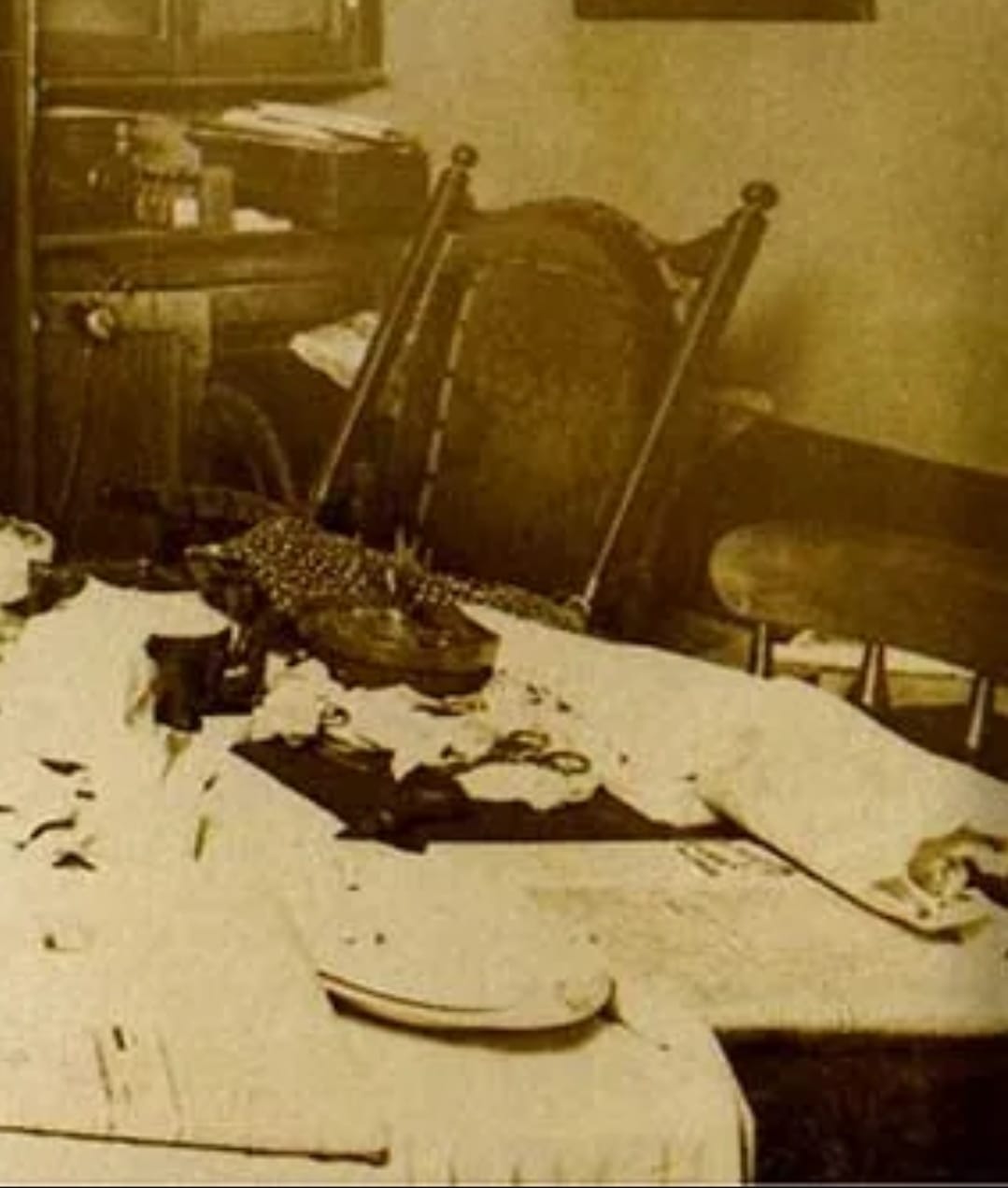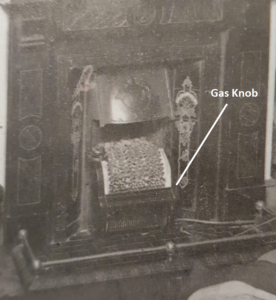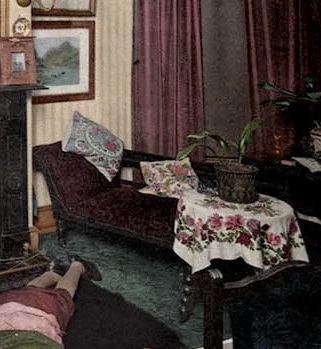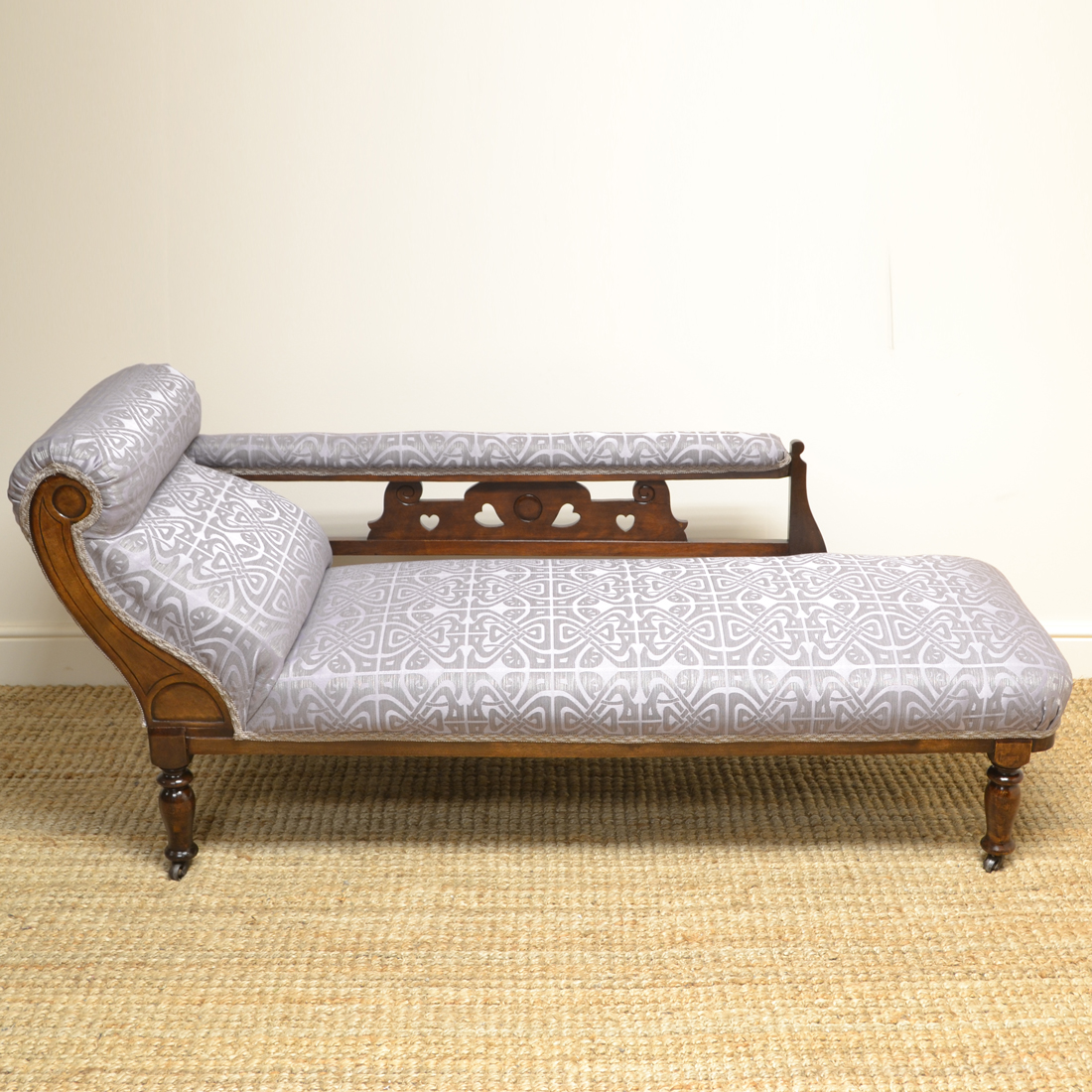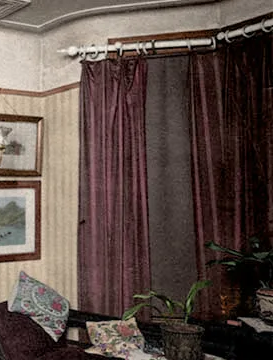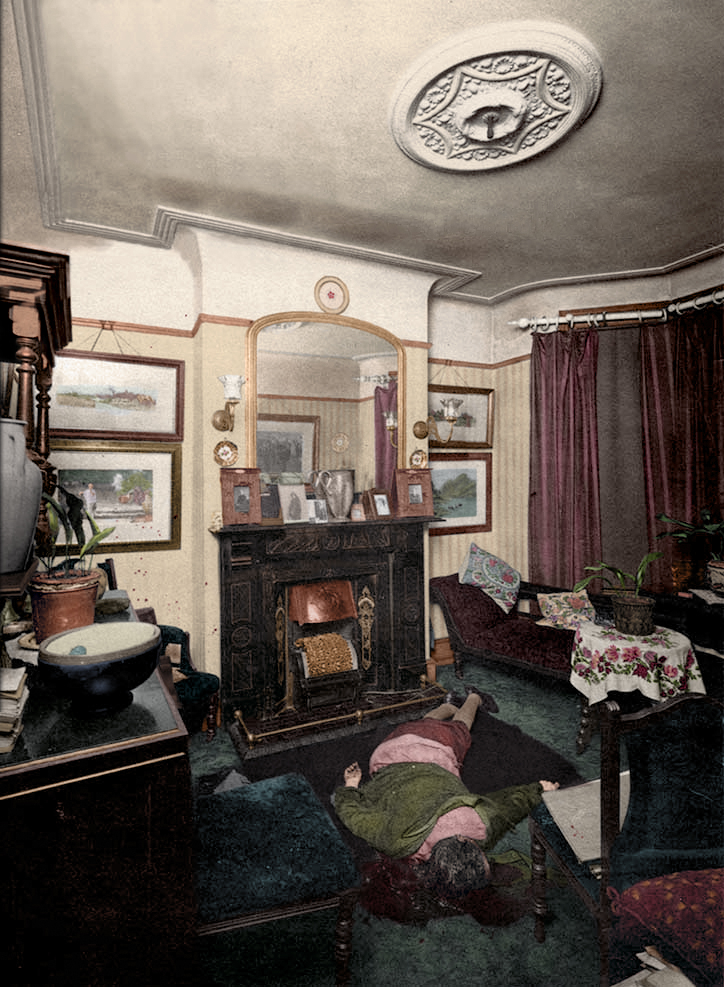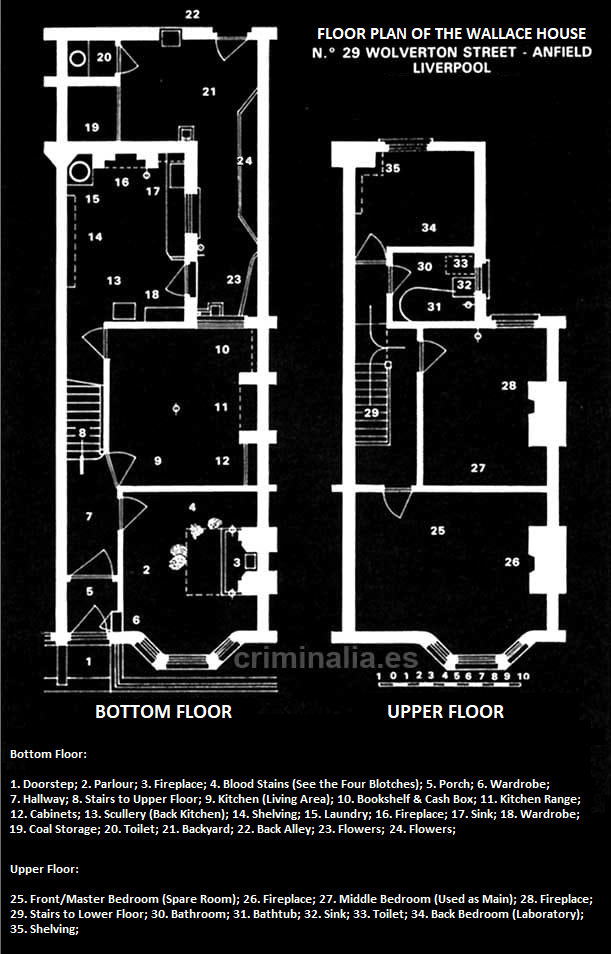Reconstruction of the Murder Scene:
It is important here to take careful note of physical clues around the crime scene so that we can put it all together.
The Kitchen…
Before moving onto the murder scene itself, there are a few elements in the kitchen (the room which contains the cash box) to note. Much of this is on the table.
There is a SERIOUS problem and utterly disgraceful display of incompetency from the police here… That problem is that this photograph of the kitchen was taken on January the 23rd. William had been allowed to stay in his house ALONE on the night of the 21st of January. Therefore the integrity of this crime scene is potentially greatly different compared to the murder night, and potentially compromised. Just to let this sink in, they have let their prime suspect stay at the scene of the crime alone before it was even photographed. Many rooms in the home are not photographed at all including where the stained notes were found, and “disturbance” (not really a disturbance) in the front bedroom… The photography – and lack of it – is perhaps the most embarassing element of this entire case, where the infantile abilities of the police force come into plain view.
This is something I have had to taken into account, but fortunately there are still some elements we can pick out…
We know from Wallace and also from the autopsy that he and his wife had shared a meal of scones after he returned home at about 6.05 PM on the night of the murder. The meal was finished at ~6.30 it is claimed, at which point Wallace got ready for his trip.
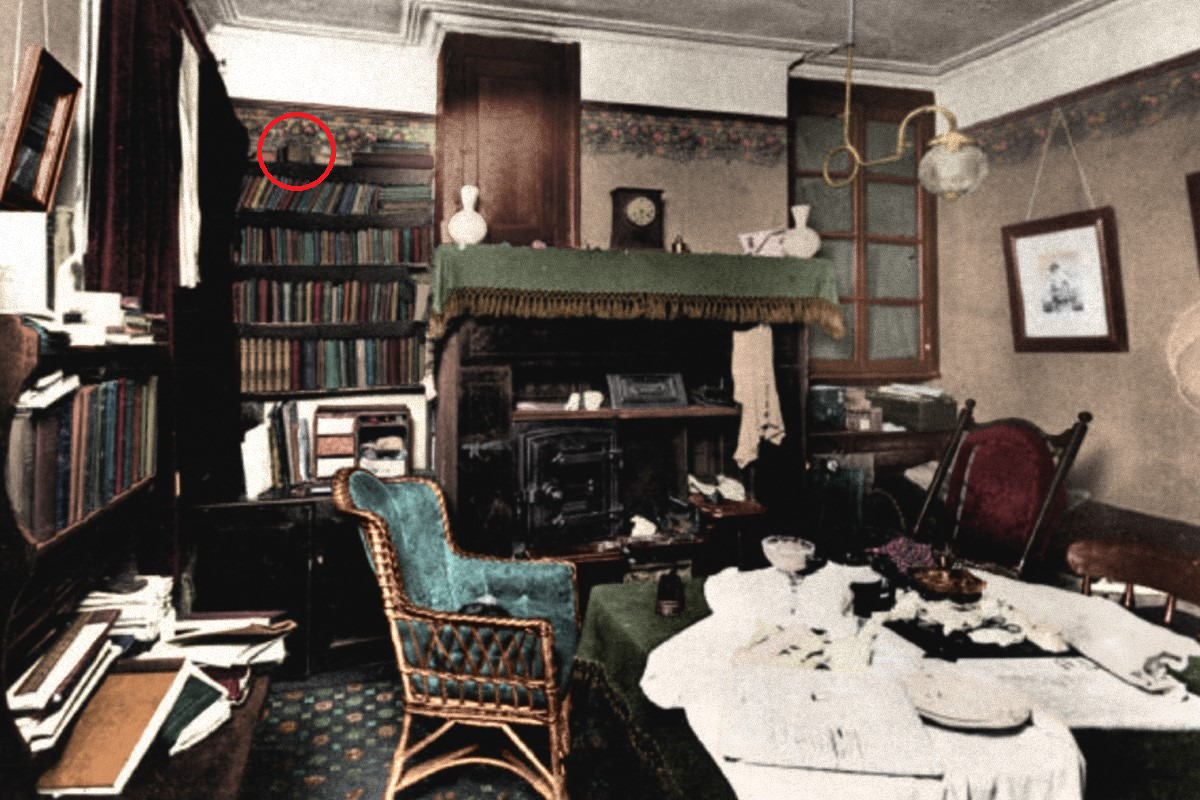
Circled: The Prudential cash box. This was in the “living kitchen” of the house.
This photograph was taken on either the 22nd or 23rd of January. MISSING from the scene are coins scattered at the base of the bookshelf unit, and a previously-mended cabinet door lying on the floor broken in two pieces.
Wallace’s side of the table appears to be to the left, and behind him where we see folders/papers, a wooden ruler, and other knick-knacks along those lines. I am thinking these would be work-related items. William probably sat here at the kitchen table when doing his books and I think it would be quite obvious to a visitor that this is the case. Therefore quite obvious to expect the company’s money would be kept close to where all of the “work things” are.
We can surmise that side of the table is Julia’s, since we see sewing equipment.
It is difficult to make some of the elements out here, but the scissors are quite evident.
Opposite Wallace’s chair we see what is presumably Julia’s chair: It seems unlikely she would choose to use the uncomfortable looking wooden chair, and likely that when sitting down for a meal with someone a person would sit directly opposite).
Draped across the table and onto Julia’s chair there appears to be some sort of patterned fabric. Perhaps this is a skirt Julia was making or mending? We know Julia enjoyed sewing and frequently made her own clothes. This was something the locals took note of: It was commonly believed that Wallace dressed well (albeit old fashioned and not in “top” quality clothing), whereas his wife was a little more ratty in homemade outfits way past their time.
There are two newspapers on the table, most probably we can guess these are the Financial Times and The Liverpool Echo, but because of the date the photograph was taken there are some issues. For example, I cannot find if any further papers were delivered to the house after the murder (in which case the ones on the table may not even be from the day of the killing). According to Jonathan Goodman on the day of the killing, the Echo on the table was found open at its center pages implying it has been read or at least casually opened and glanced at.
I was not able to find this in statements but found vindication of this claim in the appeal trial:
MR ROLAND OLIVER: I need not read his evidence, because your Lordships know what he said, but my point about Jones, if I may venture to repeat it, is, not the certainty when he left the paper, but certainty that that woman was alive when the paper was put into the door, because the paper had been taken in and was lying on the kitchen table, apparently having been read, after the murder.
THE LORD CHIEF JUSTICE: Or at any rate opened.
MR ROLAND OLIVER: Or at any rate opened, yes, my Lord, and lying on the kitchen table.
Since this photo is taken days after the murder as explained, the photograph is not representative of how the scene was at the time. But possibly the papers were the same ones and in the same position; simply disturbed. The best I can do is to compare the newspaper from that date with what’s on the table, keeping in mind there is some chance what’s on the table is not even what was there on the day of the murder:
Here is the front page of the Liverpool Echo, 20th January 1931:
And on the kitchen table:
It does not appear to be a match for the layout and font on the front page (there is some sort of large header at the side of the page on the table), and therefore it does appear to me to be an interior page it is open to, but it could also be the back page. The Newspaper Archives only have 12 pages so I am not able to find a match for which page it is likely to be unfortunately. If a copy of this paper could be found, we could determine the contents of the page it was found open to and therefore determine whether the content of that page is something Julia would be likely to have been interested in.
On top of the newspaper there is some sort of fabric… a sheet perhaps? This vital clue is also now lost to the factor of possible interference etc: It is not possible to say if the fabric/sheet we see on top of the newspaper was on top of it when first discovered, or indeed if that was even the newspaper found on the murder night. If we could know this, we could ascertain whether it is likely someone had read the paper before beginning sewing work.
However we can ascertain that in probability someone brought in the Liverpool Echo at around 6.30 PM. Since Allan Close’s milk delivery was after this, it is likely Julia would bring in anything at the door at this point (even if after shutting the door on Allan), and Allan never mentioned having seen a newspaper on the floor.
The needlework we can presume Julia had started on after the meal since we see the fabric (a dress?) in the place where we would expect her to have put her plate. It is unlikely she would eat on top of a garment she is working on otherwise it would be likely to get crumbs upon it etc. it is simply unnecessary when it would be so easy to place the garment aside, especially on the sofa behind her which we will see shortly. Regarding the needlework, an officer who was on the scene on the night of the murder confirmed that it had been there. According to him, upon the table was a sewing basket and wool, and he formed the opinion that Julia had been darning or knitting when she left the room, never to return again.
It was around 6.37 PM that Allan Close came to the door. At this time Wallace claimed he was upstairs brushing his hair and getting dressed in the middle bedroom which he shared with Julia.
If he was actually getting dressed at this time that is unexpected in a scenario where Wallace is the killer, since Allan Close is already very late. Allan is expected to arrive earlier, as early as 6.00 PM (sometimes when Allan was late his coworker Elsie Wright delivered for him), and should Wallace be attempting to leave as soon after the milk boy as possible, we would expect he would already be dressed etc. by now.
Another version of the photograph with different contrasting brings out different details:
Here you see more clearly the objects on the table, but importantly I’d like to draw your attention to what appears to be a sofa or chaise of some kind up against the wall? The armrest/headrest being visible to the left of Julia’s chair. There appears to be a sheet on the armrest/headrest which we see the end of just to the right of Julia’s chair; and the sofa appears to continue along the wall to the end of the photograph if we follow the dark line. There seems to be something like sheets/cushions/paperwork on the seat of the chair, visible to the right of Julia’s armchair.
A couple of years prior a nurse had tended to the Wallaces. She stated that while William was unwell, Julia had slept on the sofa in the kitchen.
The importance of this is that if there is indeed a sofa type chair in the kitchen suitable for napping, it is then far less likely she would go into the cold and damp parlour alone for a nap on the chaise where someone who broke in might have found her – the sofa in the warm kitchen is a far better choice.
To the right of the photo appears to be a radio. This would have been the staple for digital entertainment in the Wallace home. By Wallace’s diary it sounds as though the couple had on occasion listened to radio productions of various plays. The Johnstons did not report hearing the radio that day, although their kitchens border each other and the radio is against their shared wall. It was never asked or mentioned how commonly the Wallaces had their radio on, whether Julia often used it while her husband was out, or various other points which could have helped to establish a likely time of death (or even exonerated William if – for example – the radio was heard to be on when he left, and then was not on by the time he got home). It is not known if either of the neighbours at #27 or #31 had their own radios on that evening which could mask sounds from next door.
The Parlour…
The Lights:
It was declared by Wallace that when the couple were alone they would light only one gas jet, which would be the one on the right of the room. When they had company, they would generally light both gas lamps. These lamps were above the fireplace.
Julia would have her box of matches when entering the room, it was dark at this time. When she enters she would possibly (as William did) strike a match in the doorway and then make her way over to the lamps. The matches in those days were longer and she likely would have been able to use this same match to light either one or both of the gas lamps.
She may have had to strike another for the fireplace.
A few different delivery boys were asked or made statements regarding the visibility of light in the front room. This would cover a period from around 6.30 (when the paper was delivered) up to around 6.40.
None had seen a light in this room from outside. That includes Allan Close who had been at the doorstep with the door wide open. He said he could see a light on in the living kitchen where the Wallaces had just eaten, but nothing in the parlour (meaning he had seen no sign of light from outside OR even when physically looking into the home). The doors we might expect to be closed to retain heat, but still it is often the case when a room is lit that we see a glow of light through the tiny gaps between the door and its frame.
There is some evidence that light ought to be visible from outside in the front room. From the trial as Hemmerde examined William:
Q: (3649.) It was a difficult thing to come across the feet like that to the gas, but does it not occur to you as strange that a total stranger coming there murdering your wife should have troubled to turn off the gas?
A: No, not very improbable. I expect he would turn off the incandescent light and he would see then that he had left the stove on and it would be natural that he would turn that off too.
Q: (3650.) Why, because to someone passing it would show a reflection, showing the house was inhabited; why turn it off?
A: I cannot explain his actions at all.
As well as from William in his first statement to solicitor Hector Munro:
“I then went down Belmont Road, Castlewood Road, Sedley Street, through several entries till I arrived at my own front door. There had been no light in the front room when I left, and there was no light on my return.“
The implication being that if there were a light in the front room, he would expect to see it when he got back to his front door.
The Parlour Fireplace:
The door closes on the milk boy at 18:38, Wallace cannot have left his house later than 18:49 to catch that tram. Julia is in no hurry to beat any clock, it’s supposedly William who is… So she’s not rushing to get into position to be murdered. Allan Close also claims that seeing into the house, there was no light in the parlour at this time.
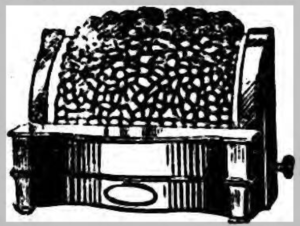
A “Sunbeam” gas-fireplace the Wallaces had in their parlour. It is meant to resemble a coal fireplace. Their model was different but still had the gas tap on the right, as mentioned during the appeal trial.
So once Julia enters the room, she would light the gas lights above the fireplace as described above. She then has to bend down at the fireplace to put on the gas leaving her back exposed to a killer who could easily come up behind her. But the burning and scorch marks on the skirt and further elements in this scene indicate that she was not attacked at this time.
I have found a video on YouTube showing the operation of gas fireplaces and I think this one would work in a similar fashion… This one has fake logs while the Sunbeam has fake coal:
I have heard from older people that these fireplaces were very finicky, and would rarely light right away, instead taking some time “swearing at it” until it finally worked. As quoted from a forum poster by the name “Al Bundy’s Eyes”:
Why is a killer waiting around for her to fiddle with the fireplace? She’s already on her knees to light it and regulate the gas – the perfect opportunity to strike. For William himself, this is meant to be a man apparently determined to do everything inhumanly fast to provide himself with an alibi, why is he dawdling when he has apparently planned this so long in advance and knows exactly what he’s going to do and how? It seems more likely he would attack as quickly as possible.“All the old gas fires we had had to be held “on” for about 30 seconds or there about or they shut off as a safety measure. They’re also tricky and never light first time, so you’d be on your hands and knees swearing at it.”
And if he strikes her now, how did the burning come to be, since burning as we saw would apparently require the fireplace to have heated up. The model of that fireplace has no open flame, instead it conducted heats through radiants which would take at least some time to heat up. In these times it was common in most homes for there to be coin meters (robbers would in fact often break into these), it would be unexpected for a person to waste money heating an empty room. Although Julia is unwell with bronchitis it was stated by an officer at the scene that she had on very heavy clothing, including two skirts, all of which he presumed was for protection against cold weather. Hence in the most obvious scenario it would seem as though the fireplace would not be lit in advance.
It applies to any pre-meditated murder scenario that a killer would be unlikely to dawdle for so long before commencing the attack.
If the lighting of this fireplace requires the removal of the grate at the bottom of the fireplace, this has evidently been replaced and is further evidence that the fireplace was not being lit when the attack took place.
The Box of Matches:
There is a box of matches on the table in the bay window beside the chaise lounge. This box was pointed out by Florence Johnston, and William said they were Julia’s.
If Julia was attacked while in the process of lighting the fireplace, she would probably be holding the box. It also seems likely that after being attacked they would be found near the body or even have blood upon them.
But the importance of this box is crucial since it is on the table out of reach of Julia (or where anybody lighting the gas jets or fireplace would be). This is a strong indication that the parlour had just been set up, and then the match box was put down on this table afterwards.
A number of additional details regarding this:
1. We can discern from Florence’s question to William that people at the time were expected to carry their own personal box of matches. None were found on Julia or near her body, so we can assume that William was likely right in his response that the box was Julia’s.
2. If it was a box that was always left in the room, its likely position would be by the sideboard near the parlour door. It is unlikely that in the dark, a person would enter the room and stumble across the room past tables and such to get the box. Rather it would be kept near the door within easy reach.
3. If Julia had been turning out the lights and fireplace when attacked (another interpretation to explain her position in the room), the room would be put into darkness, and as such she would probably grab her matches before doing this so that a) she could strike a match to see her way out of the room and b) because she would take her personal box with her when leaving the room.
4. Even if we presume the parlour was set up some time in advance of the murder taking place, even with the room set up Julia when leaving would probably have taken this box with her. As her personal box we can expect her to carry it with her.
Therefore even with an already-set parlour, if appears she has entered the room and placed her match box down on the table. She would not do this if she was about to turn out the fire and lights, and this would also provide another fine opportunity for the killer to strike Julia from behind, particularly if he is thinking he needs to do this extremely quickly…
To expand upon that: No killer would assume it is likely the tram would just be there waiting for them, they would expect a probable wait time of some sort, adding to the urgency and hence the oddity of passing up so many opportunities to commence the attack.
The simple explanation is that Julia was lounging on the sofa (covered in the next point) and the box was on the table by the sofa so as to keep it close to her.
The Chaise Lounge:
By the bay window is a chaise lounge. According to Gordon Parry in an Empire News article after William’s death, this appears to be the seat which Julia would choose when entertaining company:
“I stood up as he entered the room; the wife was reclining on the couch. There was a look of sneering discovery in the eyes of the man and my reply was a glance at the untidy figure on the couch. I spoke of the business I had called to discuss and after a while he covered up his temper and we talked of the matter in hand.
Later I left the house – relieved to do so. The woman had not moved from the couch, and there was not the slightest indication of a meal.”
If we look at the cushions on this chair, we notice that one appears to be in the position of a headrest, while the other is kind of jammed down into the side of the chair, as though someone has been reclining in it as per Gordon’s statement. The last time the Wallace’s had company in that room was on Sunday, two days prior to the murder. Amy Wallace was received in the kitchen on the Tuesday (the day of the killing) and did not go into the parlour.
To explain what a chaise lounge is (in fact “chaise longue“, pronounced “shayz long” meaning “long chair”):
“A chaise, or chaise lounge, is an upholstered sofa in the shape of a chair that is long enough to prop one’s legs up on.”
Unlike a couch, these types of chairs tend not to have two ends, rather they look something like a strange bed or psychiatrist sofa:
The one in the Wallace parlour appears as though it is designed much like the one above, wherein there is one “end” where the person would lay their head, and then a long segment which the person’s legs would be put up on.
Because it seems the other end of the chaise does not have a support, we can surmise that a person sitting on this sofa would always sit on the side with the rest, so they would be right beside the fireplace. It also seems by the design of the chair, that it might even feel awkward or uncomfortable to sit on it as though it were a normal couch, given that the Wallace’s chaise is not fully backed (more like an armrest type beam runing along), and that the headrest area is sloped.
Julia would not be lounging in the room for a business client of Wallace’s if Wallace was still in the home, since it would be Wallace who would deal with the client.
All in all this seems to be where Julia had been and from where she had risen which ties in now with the next point.
Julia’s Feet:
Experts place Julia on the right of the fireplace when first hit which changes things very dramatically from the suggestion of McFall.
“I recognize that McFall and others think she was left of the fireplace. What bothers me about that is the position of the feet. If the attacker hit her while on the left of the fireplace and then dragged her by the hair to her final position, he would then need to lift the feet/legs up and move/toss them to the right of the fireplace. That seems unnecessary during a frenzied attack.”
If we look at where her feet are, we can see that it appears she has been moving from the couch (having just recently stood up) towards the door leading out of the room.
It should also be taken note of that she is wearing some sort of shoe. In England it is considered a social norm to not wear shoes inside the home, particularly if the home is carpeted as is the case at the Wallace house. Generally a person would wear slippers or just socks. When entering a person’s home, it is typical to ask if you should take your shoes off. I am not able to tell what sort of footwear Julia has on (whether they are indoor or outdoor type shoes) so cannot do much with this. But somebody else reading this might (if so, please leave a comment).
When leading her husband down the yard, if she had slippers on it is such a short walk and on cement, that I think she would probably not bother changing her shoes. But if she had gone out (for example, to look around the block for the cat etc.) she would probably change shoes into outdoor-wear. If she has outdoor shoes on here and did not have them on when William left the house, we can determine she had gone out for some reason, and when she re-entered the home she did not then bother to change out of them. Alternatively that she was expecting she was about to go out.
The Blinds and Curtains:
According to Albert Wood, Julia would do the following when setting up the parlour:
“In Winter the gas fire used to be lit & if I called when Mr Wallace was out Mrs Wallace used to get the matches, light the front room fire, and pull down the blinds.”
Looking carefully we can see that the Wallaces appear to have a set of blinds behind the curtains. The white rungs and bar correspond to the curtain, whereas the darker bar appears to be for the blinds. It would appear then, that Julia has pulled down these blinds as Albert Wood said she would.
From his statement there are a few important details we can discern:
That it was Julia’s practice to draw the blinds after lighting the fire; that the blinds were left up by default; and that the fire was probably put on before they were drawn.
Further, at the time it is proposed that Julia would have set the parlour up, there were a number of people in the streets. Window cleaners, delivery boys, and others milling around or returning from work. Since we can infer from Albert Wood that the blinds are left up by default, passerbys would have seen a light go up briefly in the front windows of the house as Julia drew the blinds. Delivery boys were quizzed on this matter and none had seen a light in the parlour, including Allan Close who had stood at the doorstep looking straight down into the house (the parlour door being the first door to his right from here).
It was dark outside on the street with few street lamps, and this is before WWII and therefore before the “blackout” blinds people may have had fitted. It might be expected that if a light was on in this room a person outside may have seen it – which is probably why this question was asked of multiple delivery boys.
The Scorching of the Skirt:
Evidence suggests that Julia has actually fallen into the fireplace, her skirt going directly onto the fireclays (the fake coals on the “Sunbeam” gas fire they had) causing scorching.
“2628. You saw [Julia’s] skirt was burnt? I noticed as I turned over the body the skirt was burnt in the front.
2629. Whereabouts was it burnt as she was wearing it? Directly opposite her private parts.
2630. Right in the front? Yes, as worn, where you fasten it up.
2631. MR JUSTICE WRIGHT: What is the proper name of it? The flap was here in the front and I should say that the flap should be at the side from what I know of female wear.”
– Detective Harry Bailey
And:
“At the bottom of [Julia’s skirt’s] Placquet there were 3 recent horizontal burns, which could have been caused by contact with the hot fireclay of a Gas Fire such as was in the Parlour at 29 Wolverton Street.”
– Police Analyst William Henry Roberts
Therefore when attacked, Julia must have been in a position where the impact sent her into the heated radiants of the Sunbeam fireplace briefly, scorching her skirt.
This means she got up from the chaise lounge for some reason when she was then attacked, sending her into the fireplace. She would not fall into the fireplace if she was attacked while still on the chair. The heat of the radiants, the blinds, and the location of the matches suggests she had not just lit the fire when attacked – in which case the blinds would not yet be drawn and the match box would be found upon her. The radiants would also not yet be hot enough to cause burning upon contact.
The position of the matches suggests she had not just turned off the fire/lights when attacked – in which case the room would be placed into darkness and she should have her box of matches on her (for the reasons described earlier in the section dealing with the match box).
The Piano and Music:
From the other view of the room we see items relating to the Wallace’s musical habits:
On the left we see the piano, a violin stand (the metal object in front of the piano), a chair, and sheet music. Across the arms of the armchair we see Wallace’s violin case.
Of importance there is no chair or piano stool in view in front of the piano. This is simply not right. It would be expected for there to be a stool or chair in the middle of the piano facing towards the keyboard, so where exactly is it?
According to suspects the Johnstons, Florence did not notice a chair behind Julia’s head when entering the room, but instead noticed the violin stand there. This would make more sense: The piano chair (seemingly they did not have a traditional stool) would be in the middle of the piano and the violin stand to the side of it, which would allow Julia to sit at the piano while Wallace stood beside her with his violin and played along to her accompaniment.
She did not notice anyone move it, and it would not be Wallace because he was either with her or the detectives throughout who made no such comment. Is the piano chair the one with the sheet music on top of it which is just to the side of the piano in the view looking towards the parlour door?
The prosecution made the suggestion that Wallace lured his wife into the parlour with the promise of a musical evening. If this had been done, in order to play the piano Julia would have had to move the sheet music off of the chair and place it somewhere else (perhaps the empty chair which we see near the door which was originally in front of the sideboard?). This would give an attacker another chance to come up behind her.
It also suggests that if this chair was moved by a detective/photographer etc, then whoever moved it must have been very careful in their movements to not send sheets onto the floor; else they actually lifted up the sheets to move the chair and placed them back on top. Alternatively, they may have even placed the sheets on top of the chair (which had in fact been empty) from some other location. This would be extreme contamination of the crime scene and is significant in that there seems to be blood spots on the sheets. If the sheets had been on that chair and the chair facing the piano as expected, the BACK of the chair ought to have received the blood spray I would imagine, since that is what would have been towards the body.
Now… What if the piano chair is not the chair with sheets on top, but in fact the chair that was found in front of the sideboard? That appears more convenient. Generally a piano chair/stool will not have piles of music on top of it because a person is expecting to sit upon it. It is usually kept bare. If it is the chair by the sideboard I think this would prove that there had been a visitor. Simply, there is no reason at all that a person would move their piano chair over by the sideboard unless it was put there to give someone a place to sit. There is no reason for a piano chair to be away from the piano and facing into the room.
This I think seems more likely to me. I think the one chair with sheets on top was kept beside the piano as a sort of “storage chair”. This sounds odd, but we can see the same has been done with the chair barely visible in the foreground of the photo looking in towards the fireplace – the one which has a cushion on top of the sheets. I think Julia would pick sheets from this chair which was kept beside the piano and place them on the piano’s music shelf. The chair she sat on would be kept bare.
There absolutely should be a chair or stool of some kind in the middle of the piano and facing the piano. We must ask WHY there is not.
As for violin music, because there are two instruments here, it is likely the sheet music for both would be kept separate so they would not get mixed up. The piano sheets would likely be kept near the piano, while the violin sheets would be elsewhere. Possibly these were kept in the sideboard next to where the violin case is but this was not discussed unfortunately. There is no sheet music on the stand and the violin case is not open so evidently if this was the case it did not get as far as that before the attack began.
Wallace would not read music off of the piano, as tall as he was especially and requiring glasses, he would definitely want his music up on the violin stand where he can read it. He would not want to lean over to read music sat atop the piano’s own music ledge. The prosecution made an unfounded claim that the music on the piano stand was piano AND violin music. They easily could have verified this, but it is completely improbable, and seems like nothing more than a cheap shot to help their case knowing that it could not be challenged.
With musical pieces intended to be played in pairs, generally the instrument the person is playing will have its own bars/lines/whatever you wish to call them along the top, then the “accompaniment” underneath. The intention is not for the person playing the accompaniment to read from your sheet, but for your own reference as you play along.
I personally have years of experience playing both the piano and violin, both of which I began a decade or two ago. So there are some things I would add on here:
1) Violin stands can be folded away so a person might say “aha! he set up the violin stand!” but this would not be done. Violin stands are always kept open unless I suppose in the setting of an orchestra? But even then when I played in an orchestra I never had to set up my stand, I would enter the hall we played in to a sea of waiting stands. I was in the second violin section, and there would be several rows. I do not recall ever putting them away either. I suppose our conductor did this.
In my own house my stand was (as would be expected) always upright and unfolded. Like a car seat the player adjusts it to their desired height and such. Once you find the correct position for yourself, you do not want to lose this position and it’s left exactly as it is.
2) Piano lids are rarely down for frequent players. My own upright piano has a lid as I think all uprights do, and also a strip of cloth which runs across to protect the keys from dust. This lid is never down and the cloth almost never across the keys. In my piano tutor’s house, she had two uprights, one in the dining room and another in the front room where she taught lessons. In all the years that I went for tuition which must have been close to ten years, I never once saw the lid down, even if I had arranged to go on “off days” (for example, a Sunday during the lead-up to an important exam).
3) Regarding sheet music, the last piece I played is always left up on the piano’s music shelf (this can also be folded up by the way). It is quite unfortunate nobody bothered to determine exactly what that piece of music was, since the neighbours as well as certain visitors would hear the music being played, and had the piece been identified it might be possible for them to ascertain the last time Julia had played the piano.
By the looks of it Julia did not own any bound books of music (unless there are some in the sideboard), but rather a large amount of loose sheets. These are a nuisance to keep in order, and with the huge stack on two of the chairs in the scene (one just by the door, another on the chair by the violin stand), if ever these piles were knocked spilling sheets across the floor I can only imagine what a nightmare it would be to re-arrange the loose sheets in the correct order!
Given the door opens inwards towards the piano, it seems the chair with sheets just beside the piano (underneath a cushion, only visible in the photo looking in towards the fireplace) is at great risk of spillage if a person flung the door open. I am not actually sure exactly how wide that door could open, but if it could open wide enough to hit the chair, this might speak against the idea of a person bursting into the room in a panic to head off Julia after having made a sound in the kitchen.
Sounds:
Florence Johnston heard two thuds from the direction of the Wallace parlour at approximately 20.25 to 20.30.
Florence Johnston: “I did not hear any unusual noise in Wallace’s house until about 8.25–8.30 p.m. I was then in my kitchen and I heard two thumps which I thought was my father in my front parlour taking off his boots.”
Gannon, John. The Killing of Julia Wallace. Amberley Publishing. Kindle Edition.
According to modern forensics, these thuds that were heard could be the killer:
“Between 8:25-8:30pm I would suggest is definitely within the range of possibility. As a general guideline undigested food would be seen in the first two hours and more liquid food would be seen between 2-6 hours. The postmortem suggests that there were bits of unmasticated food which could be indicative of the start of digestion and somewhere between these two stages. Also, the individual variation isn’t fully known so it’s very possible that the time of death was within this window.”
If this is the case, then it is also possible the killer was indeed still in the home when Wallace tried to gain entry, which is what he said he first suspected.
We also have to remember there was probably a delay between the initial blow to the front side of Julia’s skull, since presumably a fire etc. was put out before the blows to the back of the head were struck. Therefore, if these thuds were concentrated on Julia they may have happened after her time of death.
The cause of the thuds is not clear so it could even be related in some way to the movement of the body, or anything else which we don’t know the specifics of, or unrelated to the crime in any way if Florence made a mistake in where the noise came from. This was something greatly missed by the defence counsel, since if they had grilled Florence to bring this up during the trial, the sounds eliminate William as the murderer by their timing.
Another element of sound is the knocking on the doors and such from the house on the opposite side. Apparently they heard the door shut on the milk boy at the Wallace home five minutes before they received their newspaper (this is by the way, impossible, since Wildman is their paperboy). But because they did not hear Wallace’s knocks on his front door (despite corroboration he knocked on the back, making it unlikely he was lying), the idea they should hear a knock of a visitor can be overlooked. Overall they seem like very poor witnesses to sound, having made an impossible statement about the time the door shut on Allan Close as well as missing several knocks at the front door of #29.
If we quickly take the crime scene again:
If we imagine the walls in front are transparent, the Johnston’s relative Arthur Mills would likely be found in that room there. They share only a party wall (which means it is essentially like being a room apart in the same house). Also if we imagine to the left of that room which is identical in dimension to the Wallace parlour, there will be a number of Johnston family members in the living kitchen.
We know from the crime scene that Julia has been repeatedly hit by a blunt implement a number of times, hitting her head against the ground while she was already downed. It also appears that a killer stomped out a fire.
It is very unusual that the Johnstons did not hear any of these sounds (apart from arguably Florence and her vanishing thuds), regardless of who committed the murder – even if it was William himself it is hard to comprehend.
The Holme family are three walls away and so there is more plausibility of missing sound than with the Johnstons. The Holmes are in fact rather useless by all accounts, since their statement about hearing the door close on Allan at #29 five minutes before they received their paper is completely impossible, since Wildman is the boy who delivers their paper!
In my view this factor alone casts suspicion against the Johnston family or an individual close to them. Whether William himself or any other individual had committed this act, it is very bizarre that they heard absolutely nothing of it (particularly Arthur Mills in the room adjoining the Wallace parlour): None of the fall into the fireplace, none of the pulling the body away and evidently around the room, none of the stomping out of fire, and none of the repeated bashes of the head against the ground with a heavy blunt object.
If the room had been set up in advance…
If it had already been set up (which is already unusual due to the commonality of coin-operated meters and the desire to not waste money for empty rooms), then I believe she would be attacked when entering the room. In this case it is much more difficult to explain her going all the way over to the right side of the room where the window is, sitting down, then getting up before then being attacked. This is particularly relevant with a tight time factor involved, where the assailant is proposed to have been rushing as fast as possible.
If she was turning out the fireplace and lights which would place the room in darkness, her personal box of matches ought to be found upon her.
According to Amy Wallace who visited and left at 4.30 while William was out on his afternoon rounds, Julia expected William was going out on business that night. William returned at 6.05 PM. They ate lunch which is confirmed by the autopsy showing remnants of the meal. He would have had to change plans on her at this point. When she goes to set up the parlour we have evidence she would draw the blinds. After 6.05 PM until quite a bit later was a dangerous time for this to be done, due to the amount of delivery boys in the street who could have seen a light or even Julia in the bay window as she pulled down the blinds.
The delivery boys in the streets at the time were asked by the police about this matter, and none had noticed any light go up, including, again, Allan Close who could see right into the house where the parlour door would be first to his right.
What has happened therefore seems to be this:
- Julia and William sat down for a meal of scones at around 6.05 PM, finishing around 6.30 PM roughly, confirmed by autopsy.
- Julia at some point after the meal has started or resumed needlework (this will be after ~6.30 PM).
- The Liverpool Echo was delivered at ~6.30 PM, someone brought this newspaper in and placed it on the table. By Roland Oliver it was found open, which is very suggestive (but not definitive) that it had been read.
- Allan Close arrives with the milk at 6:37 PM. Julia took the milk in. Allan Close did not report noticing a newspaper on the floor even though he spoke to her at the front door, implying it had already been taken in.
- There is at some point after a knock at the front door which Julia did not expect. She puts her cup of tea on top of the fire to keep it warm as she goes to the door.
- Julia answers the door to a visitor (or visitors) who she admits into the home and into the parlour.
- Julia who has her box of matches, struck a match in the threshold of the parlour door and lit at least one of the gas jets, and then lit the fireplace.
- After lighting the fire and regulating the gas, she sets her box of matches down on the table by the window.
- She has pulled down the dark blinds between the curtains and window, as Albert Wood claims she would do (so presumably they were not left down by default).
- She has taken the chair that should be in front of the piano facing the keys, and moved it in front of the sideboard to give her visitor a place to sit. There is no other conceivable reason why we should not see a chair in front of the piano and facing the piano unless the chair was moved to be used as a seat for a visitor.
Else it must be a remnant from the Sunday visit with Amy and Edwin who I rather wager would be entertained in the warm living kitchen as Amy was on the Tuesday afternoon (I think it likely they would only go into the parlour if the Wallaces played music to them). - She has set up the cushions on the chaise lounge, then lounged upon it as she did when guests were over. Her head would be where the cushion on the headrest was, with her legs up across the chair.
- She has for some reason then got up from the couch. This has happened after enough time has elapsed since the lighting of the fireplace for the radiants to be hot enough to scorch her skirt upon contact. This model of fireplace as we see has no open flame, and hence for anything to catch light the fire has to have already been on.
- She has then been attacked: Hit or shoved, sending her into the fireplace skirt-first.
- She has been continuously hit a number of times after this, leaving her dead.
The combination of the apparently read newspaper (according to Roland Oliver) and sewing equipment is highly suggestive of a later time of death than would be possible for William. Simply, it would necessitate that between ~6.30 and ~6.45 Julia had found time to both read some of the Liverpool Echo and put her sewing equipment on the table to do some needlework before her husband, allegedly, ushered her into the parlour to give her a good wacking. The sewing equipment, fabrics and such were the items found in front of her armchair suggesting the needlework was her last action before she left the kitchen.
There was no mention by anybody that the newspaper was on top of the sewing fabrics, and so I believe (even without photographic proof due to the date of the photo) it was put aside and found on the table in front of the wooden chair next to Julia’s armchair, suggesting the newspaper was read prior to the needlework. I also base this on the following statement; if the paper was on top of the sewing things or open in front of her armchair, he would surely conclude that reading the paper was her last action instead:
“There was a table with a dark cloth on & some chairs. On the table was a sewing basket with wool & socks for darning which appeared to me as if she had been sitting on the chair darning or knitting. Perhaps got up from the chair, leaving whatever she was doing on the table & never returned again”
It would not be a plausible suggestion that William himself would sit down and entertain himself with the newspaper knowing that within minutes he has to be ready to kill his wife as fast as possible with absolutely no blood spray upon him (no time now to wash himself), leave the house, and dash for the tram.
The simplest answer is as such: The meal ends around 6.30 give or take and William goes upstairs to get ready just as he claimed. The newspaper and milk is delivered while he is upstairs getting dressed and brushing his hair (etc) so he does not hear this. After William has left the house, Julia has busied herself by flicking through the newspaper which she put aside to begin sewing, when suddenly there is a knock at the door. She places her cup of tea on the fireplace and goes to answer it, and admits the visitor.
…
It does not look like she has been attacked when entering the room, when in the process of lighting the gas jets, when in the process of lighting the fire, or when pulling the blinds; all of which would leave the back of her head exposed and in perfect position to be struck down. Especially if William is posited as the murderer, since he is in the process of trying to “beat the clock” and would not waste time waiting for his wife to set up the parlour etc.
I do not believe any assassin, especially one attempting to do things as quickly as possible, would allow for all of this to happen before attacking Julia.
Allan Close stated that when he delivered the milk (which would be around 18:38) there was not a light on in the parlour. According to the prosecution, all of the events above have happened between 18:38 and 18:49. And the attacker has actually allowed these things to happen instead of acting during one of the many earlier opportunities that would have been available to him (namely, when Julia is stooping down to the fire or, in the case of a musical evening, shifting the sheet music off of the chair etc.).
The visitor would likely be seated on the chair in front of the sideboard opposite Julia, who was reclining on the couch as Gordon Parry said she did when guests were over. In the view of the room showing the piano this chair is moved but its position in that photograph is quite impossible, since the door (which has been taken off for the photography) would not be able to open if the chair had been there.
All modern forensics believe the mackintosh was upon Julia in some way, whether around her shoulders or held. This jacket was last worn by William earlier in the day BEFORE his last afternoon rounds. For his final afternoon rounds and his trip to Menlove Gardens he wore his lighter fawn jacket.
During the day or when only one of the two (William or Julia) were going out, the BACK door would be used.
If the jacket were put up to dry somewhere in the home with expectation it would be worn again later that day (having gotten wet during the morning rounds), there was an active fire not only in the already-warm middle kitchen but also one available in the back kitchen. The back kitchen was used for general tasks during the day and therefore would be expected to be warmer than the parlour which was usually left untouched. Not only this, it would be more convenient to grab a jacket from the back kitchen on the way out if the expectation was that it would be worn again (since the back doors are used, NOT the front, due to tram convenience).
I have the Johnstons as top level suspects (the idea of the call as a plan being the only thing which prevents them from being the obvious suspects to most people). It is therefore of high importance that Florence Johnston on trial stated that to her, it looked like Julia had grabbed the jacket to put round her shoulders to answer a knock at the door. Earlier in the day Julia had put a “bit of material” round her neck when answering the door to Neil Norbury the baker’s boy.
More On the Mackintosh…
Two modern day experts in forensic science dispute the claim the mackintosh theory would even work:
“I can’t see an attack such as this not leaving spatter upon all the clothes, even if covered by the mackintosh. Especially on sleeves and collars that wouldn’t be protected in that scenario. While the techniques of the day may not have picked up the minute spatter I would imagine at least some blood on the clothing.
I think it is more likely the two items burned at the same time, this could also explain some of the body placement if the task was to stop the fire before being noticed. I would suggest the mackintosh being on her person to be a more likely explanation, but of course there’s a lot of variation that could have occurred on the day.”
Another forensic expert – a doctor who is active to this day giving expert forensic testimony in court cases and investigating suspicious murder scenes for the police – claimed the idea of Wallace holding up the jacket as a shield and his clothes being protected from any spray is “absurd”.
A highly prevalent blood pattern analyst (who teaches forensic students and testifies in court cases) had the following insights on the matter, which due to their wish for anonymity and copyright of the typed report I had to summarize:
Analysis of mackintosh is hindered due to the lack of photographs of the patterning upon it. However, the visible portion is clean, which suggests it was not in that position during the attack and has been moved. (Based on witness statements, the mackintosh was initially more underneath Julia, and has evidently been moved aside by the time the photographs were taken).
The analyst suggests the mackintosh and skirt burning happened at the same time.
The analyst suggests that the assailant standing to the right of Julia would have little to no blood upon them anyway.
I have always agreed that it seems very odd that she was wearing his jacket which was the suggestion made by Roland Oliver and suspect Florence Johnston (that Julia had thrown it round her shoulders to answer the front door). But it is something that is suggested repeatedly that is was upon her in some way. Importantly Florence Johnston is one of the only witnesses to have seen the original position of the body and jacket.
One thing I did notice when glancing around the palour however is the sheer lack of items one could use if they were looking for a rag to wipe blood off of a weapon/their hands and feet, wipe down surfaces to clear away fingerprints, douse an active fire, or even try to stem the bleeding from Julia’s head.
It is known that Wallace’s jacket was in very easy reach directly opposite the door in the hallway, and that is one possible use I can think of… An attempt may then have been made to burn the jacket to remove evidence since the killer has handled it with bare hands, with it then being shoved under the body instead and letting the blood pool remove the evidence, because either the burning did not work/was too conspicuous, or Wallace knocked on the front door.
It could also be the case that the assertion of how it was used is correct (as a “shield”), but the prosecution simply got “the wrong (wo)man”.
The blood pattern analyst who wishes to remain anonymous, does as mentioned believe that the perpetrator could have escaped with little to no blood upon his/her person. However, she also made note of the lack of blood on Julia’s back. This led her to believe that Julia was prone when the back of her head was opened up, otherwise had she been upright, gravity would have caused blood from the open wound to drip down her back… An alternative reasoning for the lack of blood run-down is that the mackintosh had been round Julia’s shoulders… As with the other experts, it seems she believes the burning happened at the same time as the singeing of the skirt.
Regarding the mackintosh – It is also problematic to suggest that William had caught light while wearing it. Not only would this be quite clumsy (though perhaps expected during a brutal attack), but if he had his clothing on underneath the clothing should have been burned. The mackintosh was not only singed, but actually set ablaze and considerably burned. Therefore you are left with a deliberate act of arson after-the-fact, or the idea that it was held up as a shield rather than worn… In the latter case, it is hard to fathom why a person would choose to use something belonging to themselves which would clearly be quite incriminating, then dump it with the body, when it would have been possible to simply grab his wife’s jacket.
Weapons?
Apparently an iron bar or poker was taken away out of the home. This might not be the case.
As per Goodman, the iron bar (roughly 12″ by 1″) was heavily rusted and found behind the fireplace a few years later when the new homeworners were renovating by upgrading the gas fire to electric. During the investigation of the crime, the gas fire was removed, but according to Goodman the workman had found the bar down a crevice at the back near the wall, where it might have gone unnoticed at the time.
There was no mention of a handle on this piece of iron, but there was mention of a handle on the pokers in the kitchen as per the Wallace’s charwoman (essentially a maid) Sarah Jane Draper:
“There used to be two small steel pokers in the kitchen (living area where the cash box was kept) fireplace, one was about 1 foot long, that is here now, the other was about 9 inches, this one is missing, it had a small knob on it. There was a straight piece of iron kept in the parlour fireplace, it was about 1 foot long and about as thick as an ordinary candle, that is missing; last seen on January 7th.”
Now we come to the fireplace as it was photographed in the parlour and we see a straight rod-like item with what appears to be a knob on the end, like the poker which had been described by Mrs. Draper:
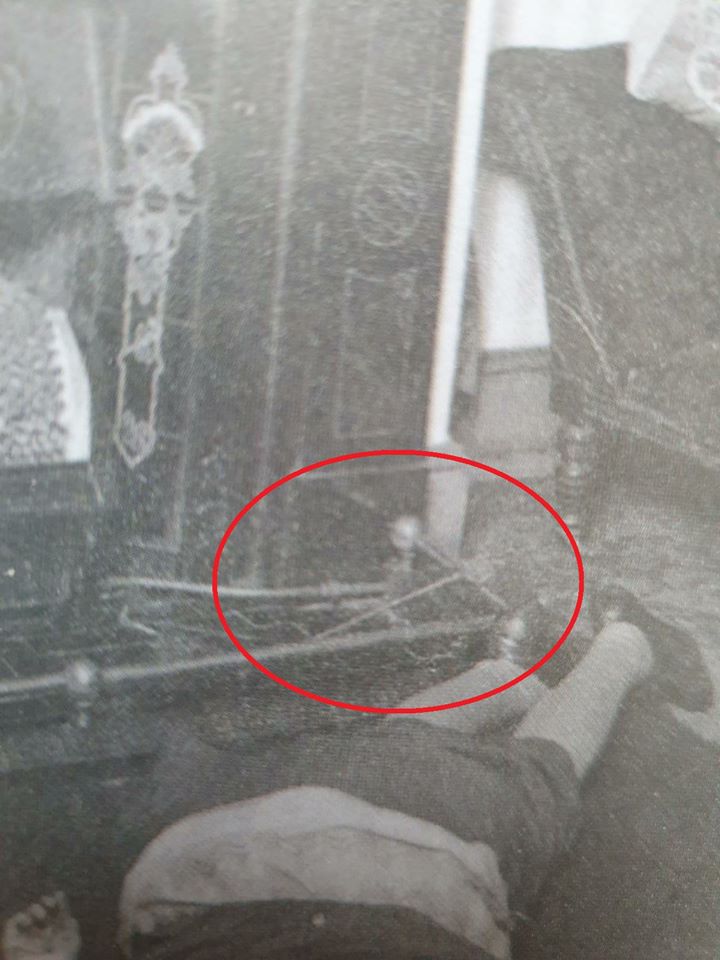
The “missing piece of iron” was 12″ x 1″ approximately, according to the charwoman, and was apparently found behind the fireplace years later. The missing poker with the knob on the end appears to be a match for the object above.
Why would a poker be in the parlour with a gas fire? The murder took place on the 20th of January, the charwoman had last visited on the 7th. She had taken a week off work and missed the 14th of January due to the death of her husband, next turning up on the 21st. That would mean that between the 7th to the 21st of January, cleaning duties would have fallen upon Julia.
If the usual piece of iron used for cleaning under the gas fire had rolled back into the crevice and was the bar found some years after by the next family who moved in during renovations, then it’s possible it was Julia herself who had brought the poker in as a substitute for the missing iron bar.
If that’s the case, then neither the iron bar nor the poker are missing, and that creates an issue as there is now no known murder weapon missing or otherwise. As stated by one of the forensic doctors I hired:
“No matter how I look at it, there is a repeating pattern in several of the injuries which would likely NOT fit a metal bar or crowbar unless there was a patterned surface.”
Before the photographer even took his photos, many things have been touched, handled, and moved. For example in the bathroom shots we see between the two photos that the plug and chain is moved, the soap removed, an object on the floor moved, and rags placed down there. In the parlour photos we notice the chairs are moved, and we know Julia’s body (!) and the mackintosh are moved from the original position. The amount of police interference and crime scene contamination was so severe that Florence Johnston said the photographs look like a “faked room” on trial.
If whatever is in the photograph above had been moved, or even if it was the kitchen poker, the charwoman may have simply seen that the iron bar and poker were not in their usual places when she looked in these rooms, and presumed them missing. You would think she would recognized an object was on the parlour fender but if it was still there – whatever it was – it doesn’t appear that she or anybody else made any mention of it.
The removal of a weapon from the home signifies a fear of fingerprint identification, and also away from a hitman – since a hitman would surely bring his own weapon. But it appears possible nothing was missing from the home.
The mentioned third forensic expert specializing in blood pattern analysis wrote a in-depth formal report of the scene which can be found here: Analysis here.
If this is correct, William could have avoided blood. Of course, it also means another killer could too, and therefore we might not expect to see any other crazed blood soaked killer running through the streets of Liverpool in such a scenario. And accounts for the lack of blood on gas jets, door handles, or outside of the parlour in general.
Why did Julia get up from the chair?
Something has evidently caused Julia to get up from the chaise lounge after the above events, and she was swiftly attacked.
In the middle kitchen Wallace found one of the cabinet doors had been snapped off, and police found coins scattered around the foot of the bookcase (upon which the cash box was kept). The cash box being 7 foot or more from the ground, a shorter man would probably need to clamber up onto the cabinets or use a chair in order to reach it and rifle through it. He would empty the money from the box, put it back, then step back down.
If he accidentally dropped coins or snapped off the cabinet door (for example if he held onto it to support himself while stepping down) this could have made a noise which would alert Julia causing her to get up from the sofa, into the position where she was then attacked.
Because Julia is still quite close to the sofa (as though she had only just stood up) when attacked, I think there might be two people in the home. One in the parlour distracting her, while another person is in the back of the house. When they make noise, Julia is alerted and goes to stand up, and the person distracting her has shoved her or attacked her to prevent her from finding out what was happening.
If there was some sort of altercation, possibly over money (many variations of this: e.g. that someone had gone in to beg for money and had been declined), I think it would have been heard by the neighbours.
As touched upon earlier, the Johnston family actually have a relative in their front parlour which is directly adjacent to the room where Julia was murdered, sharing only a thin party wall. If there had been some sort of argument I think the Johnstons would have heard it, and therefore I think in such an instance THEY would likely be the guilty party. The Holmes family on the opposite side are 3 walls away from the parlour by comparison, and also missed Wallace’s knocks on the front door when he arrived home (his back door knocks were confirmed by Florence Johnston, so it’s unlikely he lied about doing this), so I think it is more plausible they would miss sound than with the Johnstons. Add to this, the bookshelf upon which the cash box was placed (and where there were coins scattered, etc) is also against the Johnston’s home, and again 3 walls away from the Holmes. The Johnstons ought to have heard any loud sound in the kitchen.
In conclusion, because of the physical evidence within the crime scene suggesting a visitor has stayed with Julia for some time before attacking, and despite numerous opportunities to have attacked her much sooner had someone had such an intention, I do not believe this is the result of a pre-meditated murder… And especially not the result of any killer in a hurry.
—
Wallace With an Accomplice?
There is a theory by John Gannon that while Parry is the caller, and Marsden the killer, it was Wallace who orchestrated the entire thing. Waterhouse also proposes a theory which is very similar to this but without Marsden. Something along these lines I believe to be a good suggestion (although I am of the opinion Wallace is entirely innocent)…
According to Gannon, he unfortunately robs himself of credibiltiy by claiming on little to no evidence that Julia was paying Parry and Marsden to have sex with her, and Wallace used this to convince them to take part in a plot to murder her. Marsden was due to marry into money and such a revelation would surely have ended that possibility for him. Parry? Well there’s no real reason he would involve himself in such a thing (at least not knowing it was a murder plot), but this is the idea presented.
I believe I have seen a more solid suggestion – that Wallace was bisexual, and it was he (not Julia) paying Parry and Marsden for their “services”. With Parry’s suggestion of Wallace being “sexually odd” (often used as a euphemism for homosexuality in those days), it seems to fit. It is mostly based on a comment on Gannon’s blog (now deleted) where a man claimed his own father had told him he had been a rent boy for Wallace before moving to America, and that he had serviced Wallace for money to pay for the ticket. Whether you find that comment credible or not is up to you.
Lily Hall’s apparent sighting would also fit with an “accomplice”… And in this case, what I would suggest happened is that as Wallace left his back door to go on his journey to Menlove Gardens, the killer (Marsden) entered in his place. When he felt he was going to be arrested for the crime, Wallace then threw his two accomplices under the bus by naming them as prime suspects.

